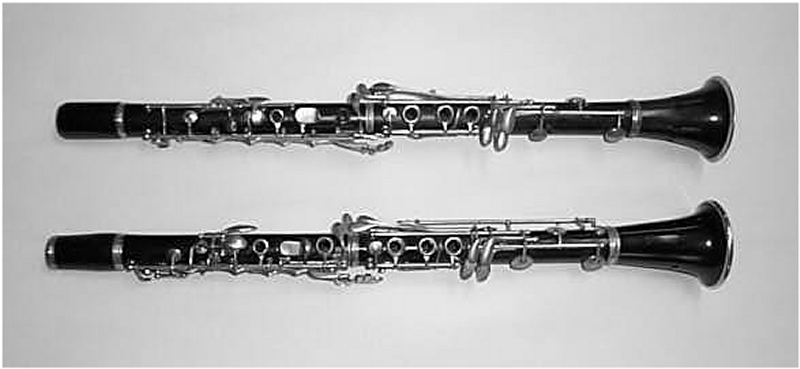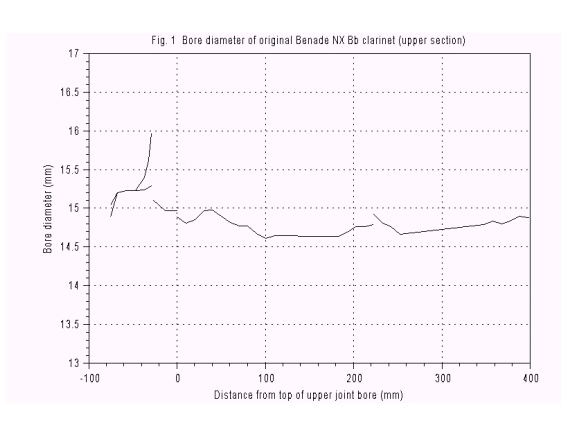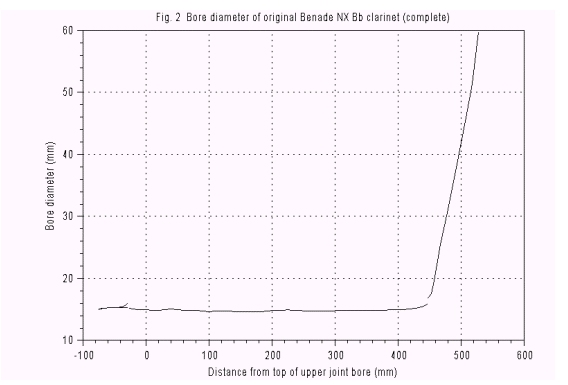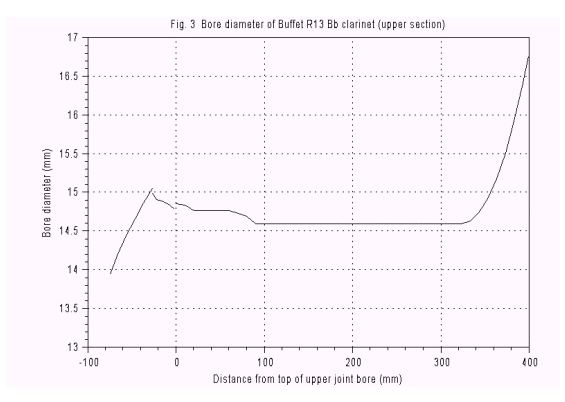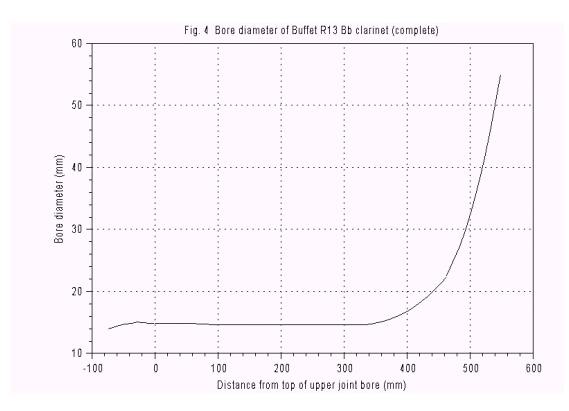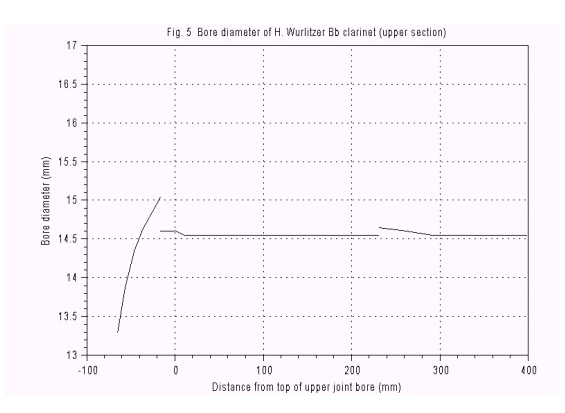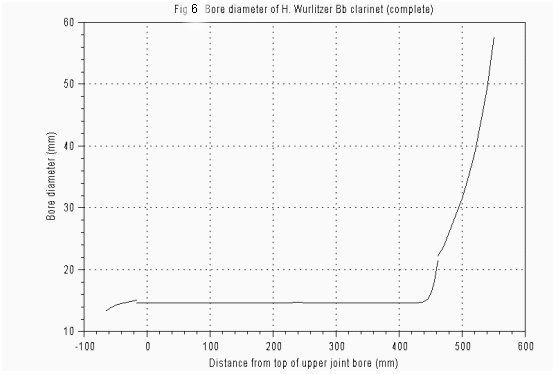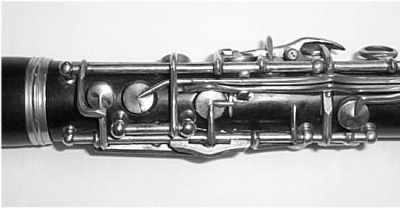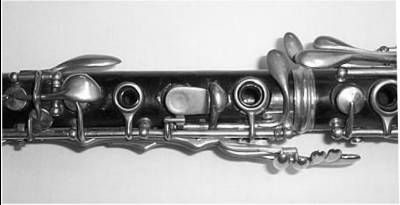Stephen
Fox
|
Stephen Fox
The Benade NX clarinet, originally
designed by the renowned acoustician Arthur Benade, will be familiar in
name if not in detail to many clarinetists through articles in The Clarinet
and demonstrations at the ICA conferences in 1994 and 2000. This
paper traces the origins of the instrument, its development in the hands
of Benade and subsequent work up to 1998. (Recent developments and
the use of the NX in real-world playing are reported on in Part
II of this article.)
History A physicist by profession, Benade was a keen amateur musician with a lifelong passion for the workings and history of musical instruments, and the practical ability to modify and construct instruments himself. His ideas on clarinet design took shape over many years; they are summarized briefly and non-technically (with the physics available in scholarly journals) in his posthumously published articles “Benade’s NX Clarinet: its Genesis” in The Clarinet, February/March 1994, and “On the Tuning of Clarinets” in The Clarinet, November/December 1990. Beginning in the late 1970s,
Benade built a pair of clarinets (starting with existing instruments and
modifying them progressively), incorporating a number of features - either
novel or inspired by instruments of the past - which he viewed as improvements
over current clarinet designs; he gave them the designation “NX” (the precise
meaning of which is no longer known). These instruments were developed
to the point where they became Benade’s preferred choice for his own music
making, and he felt that the acoustical design fulfilled his original objectives.
He was aware, however, of some awkwardness in keywork and certain other
drawbacks that could make the design problematic if offered commercially.
This work was cut short by Benade’s illness and untimely death in 1987.
Arthur Benade’s original NX clarinets in Bb and A
George Jameson, a woodwind
technician and long time collaborator of Benade’s, then took up the project
and built his own pair of NX clarinets. These were reported on in
his article “Benade’s NX Clarinet: Mechanical and Other Considerations”
in The Clarinet, May/June 1994, and presented in a lecture recital
at the ICA conference in Chicago in 1994. Jameson's clarinets were
acoustically similar to the originals but had a completely new system of
keywork incorporating a number of Jameson's own ideas, which however remained
very much at the prototype level (as well as being perhaps somewhat intimidating
to traditional eyes!). This research was again terminated by Jameson's
own passing in 1996.
Definition of the NX clarinet What is the NX? Due to the handmade nature of the originals, and the fact that Benade’s research was cut off before completion, this is somewhat less clear than one might wish. First, what the NX is NOT: It is most emphatically not the abstract creation of an ivory tower theorist. Designing a clarinet entirely from theory would be neither feasible - woodwind acoustics is too complex and subtle - nor desirable - it would be silly to waste the experience of previous generations of makers. Rather, like all practical instruments, it was conceived by taking what has been demonstrated to work well, and altering it in ways aimed at specific improvements, with theory in this case adding a valuable weapon to the designer's arsenal. It is not particularly radical or different in operation from other clarinets; the fingering only departs from the Boehm system in a couple of alternate fingerings, and the one chief adjustment required of the player is the use of a mouthpiece with an appropriate bore. It does not necessarily produce an unfamiliar sound, but rather presents a different, possibly more efficient, route to the kind of tone to which clarinetists generally aspire but which the vast majority struggle to achieve on conventional equipment. It is not, alas, perfect
in all respects (as some people apparently expect or demand!); no instrument
in the real world could ever be. It is believed, though, that the
inevitable design compromises are handled somewhat better than is normally
the case.
The NX, as conceived by Benade, is characterized by: 1. A distinct bore shape (described in detail below), including the bell and also the mouthpiece bore. 2. Essentially Boehm system tone hole and key layout, with two notable exceptions. 3. Use of an optimally sized register tube, with minimal disruption of the bore; this necessitates an additional tone hole for throat Bb, with accompanying mechanism. 4. An attempt to eliminate some redundant tone holes (i.e., two or more holes at the same distance down the body); this leads to a different arrangement of the left hand second finger hole and alternate fingerings for Eb/Bb. 5. Careful adherence to principles of minimizing turbulence in the air column (especially that caused by the interaction of closely spaced sources of turbulence), by ensuring sufficient spacing between tone holes, sufficient depth of holes and sufficient pad opening height, and by rounding of all potentially sharp edges in the airsteam. 6. Final adjustment by measuring and aligning the resonance frequencies of the air column in order to produce optimum tone and response; something that must be a feature of any fine wind instrument whether the maker realizes it or not, but in this case applied explicitly and systematically. (Space does not permit a
full description here of the process of measuring the resonance frequencies
of each fingering and relating this to the tone quality, response, stability
and strength of each note; this would be a topic for a future article.)
Detailed description of the
original NX Bb clarinet
Bore shape The accompanying graphs show
the bore of the original Benade NX Bb clarinet and associated mouthpieces
(Figs. 1 and 2), and for comparison a Buffet R13 with Vandoren mouthpiece
(Figs. 3 and 4) and a Wurlitzer German bore Boehm system clarinet with
Zinner mouthpiece (Figs. 5 and 6).
The most immediate observation is that, in contrast with the relatively smooth and regular bore shapes of the factory made clarinets, that of the NX appears very “bumpy” and irregular. The bore of the NX was arrived at by starting with the simplest possible shape- a cylinder with a cone attached- and then progressively modifying it based on measurement of the resonance frequencies for each fingering. These adjustments were made by a combination of reaming and hand scraping to create localized enlargements in the bore, and lacquering to reduce it. Once one looks beyond the irregularities, some conclusions can be drawn: The minimum bore diameter is around 14.65mm, within the range used on standard modern French style clarinets. This should put to rest the myth (e.g., “Claranalysis”, The Clarinet, February/March 1990) that Benade was an advocate of large bore clarinets. The expansion in the top part of the upper joint is of neither the usual polycylindrical or conical forms, but instead could be called a “cavity” shape, reaching its largest extent in the region of the register hole and contracting slightly above that. The lower joint shows a very gradual expansion for a considerable portion of its length, followed by a slightly wider flare, to about 16mm. This is roughly midway in concept between the mostly cylindrical lower joint of the German clarinet and the long, radical flare of the French clarinet. The bell is conical, with a much wider angle than usual. (The shape of the bell bore is one of the features borrowed from some early clarinets, being based on that from a Müller clarinet from the 1820's.) There is also a row of vent holes around the bell, whose purpose is both to adjust the tuning of the bell notes and to improve the efficiency of sound radiation into the room. At least two mouthpieces
were made by Benade for the NX, both of which (designated by him as KNX
and LNX) are shown on the bore diagram. They have mostly cylindrical
bores of around 15.2mm diameter, with an additional flare at the bottom
end; thus they have a considerably larger bore volume than a "standard"
mouthpiece. Why would a small bore clarinet need a large bore mouthpiece?
Largely to compensate for the flattening of the altissimo register by the
smaller register tube (see below); or, to put it the opposite way, the
oversized register tube of the conventional clarinet requires a reduction
in mouthpiece bore to bring the high notes down to acceptable pitch.
Register/throat Bb mechanism and trill keys An optimally proportioned (i.e., smaller diameter than usual) register tube is used, in order to minimize sharpening of the top and bottom of the scale caused by the register hole. (An empirical formula relating the length and diameter of the register tube is given in Benade’s Fundamentals of Musical Acoustics.) This necessitates an automatic mechanism operating separate holes for the register function and throat Bb; improvement of the quality of the Bb is thus an additional bonus. Another requirement for the register hole is that the tube should project as little as possible into the bore, so as to avoid turbulence and an unwanted local perturbation in bore size; this means that it should be located on the side or the top of the tube, as with German clarinets or older Albert and Boehm system designs. The hole that was formerly
the Bb trill key hole is used as the normal Bb hole, connected to the register
key by a rocker arrangement (similar in principle to the octave key on
certain saxophones); the selection of register or Bb hole is made by the
position of the A and G# keys. The second trill key is used to open
a new tone hole in the B natural position, in addition to the Bb hole;
the top trill key (for C) also opens the B natural hole. This gives
an improvement in some throat tone trills (similarly to the Mazzeo custom
clarinet) at, however, the expense of an easy A-Bb trill.
The register/trill key mechanism
L.H. 2nd finger and Eb/Bb fingering Any time there is duplication of a tone hole, i.e., more than one tone hole at a certain distance down the body of a woodwind instrument, there is in effect a localized "bulge" in the bore; this is acoustically detrimental and should, at least in principle, be avoided. In particular, the Boehm
system clarinet has no fewer than three holes for Eb/Bb (the left hand
second finger hole and the right and left hand Eb/Bb holes) along with
a hole for E/B. On the NX these four holes are replaced by two: a
hole on the side for Eb/Bb (opened by either the right hand or the left
hand key), and a single hole (instead of a ring and a pad) closed by a
plateau for the left hand second finger. This is another debt owed
by the NX to early clarinets, as it allows the possibility - or at least
the hope - of a left hand fork Bb fingering.
The left hand second finger mechanism
Making the fork Bb fingering practical and an integral part of clarinet technique was one of Benade’s main ambitions with the NX. The originals had the fork fingering but not the normal Boehm-style bridge key Bb connection; this is in fact the likely origin of the designation “NX” (for “non-Boehm”). Later, though, Benade expressed the need to install the bridge key fingering in addition, and Jameson attempted to incorporate this into his instruments. Both Benade and Jameson wrestled with the vexing problem of how to access the alternate Bb fingerings with the single left hand second finger hole. The problem is that with the tone hole proportions used on modern clarinets, a simple fork fingering (L1 and L3) inevitably leaves the high Bb sharp. To bring it in tune, the second finger pad must be brought down fairly close to the hole, by means of a ring for the third finger; the result is a note that, if not voiced correctly, could be accused of being stuffy, unstable or at least weaker than the surrounding notes. The bridge key Bb requires the pad to be still lower, producing an even more tenuous note. Using a perforated plateau for the second finger, as Jameson did, does not seem to help much, unless the perforated pad is so thick that the resulting additional tone hole volume spoils the whole point of the exercise. A player who is not sympathetically disposed (especially one who tries to beat a clarinet into submission with a hard reed) will claim that these notes do not exist at all (and it is an unfortunate reality of being an instrument maker that one’s instruments must be built so as to satisfy unsympathetic players!) A further disadvantage is that neither the left hand fork nor the bridge key fingering works at all for Eb in the low register. (It must also be admitted
that the NX makes no attempt to eliminate two other duplicate tone holes:
the F# trill hole, close to the thumb hole, and the B/F# hole, close to
the right hand first finger hole.)
Low F tuning key The NXs of Benade and Jameson
had a key for the right thumb to sharpen bottom F slightly.
Playing properties Benade’s original NX clarinets are kept quite closely guarded by Virginia Benade, and playing them is only permitted under controlled circumstances. Although playable, they are not in optimum condition for high-level performance, and full restoration is not on the agenda due to the fear of altering them irretrievably. A major obstacle to testing is the absolute necessity to use a mouthpiece with an appropriate bore shape, in contrast to a standard French/American model. Since it is virtually impossible to make a worthwhile assessment of any clarinet using an unfamiliar mouthpiece, anyone attempting a serious trial of these instruments should arrive equipped with a suitably modified mouthpiece. Thus, detailed impressions and conclusions are difficult to draw from the originals. Complete testing is however possible using reproduction or derivative instruments, and is discussed in depth in Part II of this article. There is a recording extant of these instruments, from George Jameson’s lecture at the ICA conference in 1994, with the NX Bb clarinet played by Stephen Umans. Benade’s later writings on clarinet design contained some statements about the inflexibility and poor response of post-WWII clarinets resulting from the quest for automatically perfect intonation without, in his words, “using one’s chops”. This has, perhaps understandably if misguidedly, led some to believe that Benade, despite his primacy as an acoustician, was out of touch with modern clarinet playing technique and hence with the goals of present day instrument design philosophy. There is no need to debate
this here except to give reassurance that the NX is indeed perfectly compatible
with standard, current playing technique, and that it certainly requires
no more embouchure adjustments for tuning than any other clarinet.
Conclusion Although, as with any instrument, design work on the NX continues, sufficient progress has been carried out to date to indicate that the basic concept can provide a worthwhile alternative to conventional clarinets. Arthur Benade himself, apart from his contributions to acoustics and musical instruments in general, deserves in the present writer’s opinion to be spoken of in the same breath as such figures as Ernst Schmidt (originator of the Reform-Boehm clarinet) and Robert Carrée (designer of the postwar Buffet R13) as a significant contributor to the development of the modern clarinet. Acknowledgement and appreciation
must be extended to Virginia Benade, whose generosity in providing access
to Benade’s instruments and private papers in the spirit of the open sharing
of information, in addition to her encouragement and hospitality, have
made this research possible.
|
|||||||||||||||
